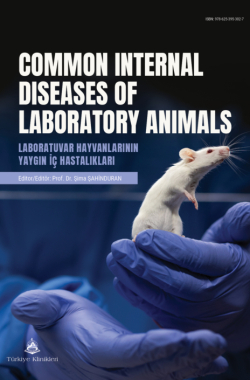Actinomycosis in Hamsters
İlknur KARACA BEKDİKa , Öznur ASLANa
aErciyes University Faculty of Veterinary, Department of Internal Medicine, Kayseri, Türkiye
Karaca Bekdik İ, Aslan Ö. Actinomycosis in hamsters. In: Şahinduran Ş, ed. Common Internal Diseases of Laboratory Animals. 1st ed. Ankara: Türkiye Klinikleri; 2024. p.70-2.
ABSTRACT
Actomycosis infections are rare in hamsters. The causative agent is Actinomyces bovis and is characterized by abscess-like swellings in the head and oropharynx region. Diagnosis can be made by clinical findings, content culture, gram staining, cytology, immunofluorescence test, polymerase chain reaction test (PCR). In treatment, drainage of the lesion and long-term use of β-lactam antibiotics are recommended. In the presented chapter, information about actinomycosis in hamsters has been reviewed.
Keywords: Actinomycosis; diagnosis; hamster; treatment
Kaynak Göster
Referanslar
- Pujic P, Beaman BL, Ravalison M, Boiron P, Rodriguez-Nava V. Nocardia and actinomyces. In: Tang YW, Sussman M, Liu D, Poxton I, Schwartzman J, eds. Molecular Medical Microbiology. 2nd ed. London: Academic Press; 2015. p. 731-52. [Crossref]
- Gajdács M, Urbán E. The Pathogenic Role of Actinomyces spp. and Related Organisms in Genitourinary Infections: Discoveries in the New, Modern Diagnostic Era. Antibiotics (Basel). 2020;9(8):524. [Crossref] [PubMed] [PMC]
- Van Dellen JR. Actinomycosis: an ancient disease difficult to diagnose. World Neurosurg. 2010;74(2-3):263-4. [Crossref] [PubMed]
- Behbehani MJ, Jordan HV, Heeley JD. Oral colonization and pathogenicity of Actinomyces israelii in gnotobiotic rats. J Dent Res. 1983;62(1):69-74. [Crossref] [PubMed]
- Howell A Jr. A filamentous microorganism isolated from periodontal plaque in hamsters. 1. Isolation, morphology and general cultural characteristics. Sabouraudia. 1963;3(1):81-92. [Crossref] [PubMed]
- Howell A Jr, Jordan HV. A filamentous microorganism isolated from periodontal plaque in hamsters. II. Physiological and biochemical characteristics. Sabouraudia. 1963;3(1):93-105. [Crossref] [PubMed]
- Howell A Jr, Jordan HV, Georg LK, Pine L. Odontomyces viscosus, gen. nov., spec. nov., a filamentous microorganism isolated from periodontal plaque in hamsters. Sabouraudia. 1965;4(2):65-8. [Crossref] [PubMed]
- Gerencser MA, Slack JM. Identification of human strains of Actinomyces viscosus. Appl Microbiol. 1969;18(1):80-7. [Crossref] [PubMed] [PMC]
- Frisk, CS. Bacterial and fungal diseases. In: Suckow, MA, Stevens KA, Wilson RP, eds. The Laboratory Rabbit, Guinea Pig, Hamster, and Other Rodents. 1st ed. London: Academis Press; 2012. p.797-820. [Crossref]
- Sullivan DC, Chapman SW. Bacteria that masquerade as fungi: actinomycosis/nocardia. Proc Am Thorac Soc. 2010;7(3):216-21. [Crossref] [PubMed]
- Mayer J, Donnelly TM. Small mammals: hamster. Clinical Veterinary Advisor: Birds and Exotic Pets. 1st ed. USA: Saunders; 2013. p. 285-99.
- Gorlin RJ, Chaudhry AP. A note on the occurrence of Actinomyces bovis in the hamster. J Dent Res. 1959;38:842. [Crossref] [PubMed]
- Quesenberyy KE, Donnelly TM. Disorders and diseases of hamster. In: MSD Manual Veterinary Manual. 2020. [cited: March 01, 2024]. Available from: [Link]
- Booth SJ. Diseases caused by actinomyces species. In: Reference module in biomedical sciences. New York: Elsevier; 2014. p.1-3. [Crossref]
- Smith AJ, Hall V, Thakker B, Gemmell CG. Antimicrobial susceptibility testing of Actinomyces species with 12 antimicrobial agents. J Antimicrob Chemother. 2005;56(2):407-9. [Crossref] [PubMed]

